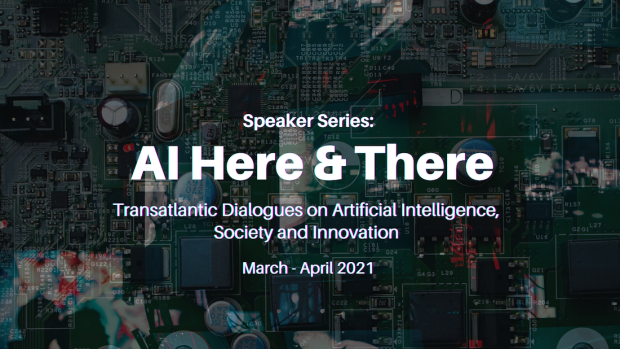The Art of AI

“AI Here and There: Transatlantic Dialogues on Artificial Intelligence, Society and Innovation” is a four-part series jointly organized by the Center for Responsible AI and the Consulate General of Switzerland in New York. The fourth and final event in the series examined how AI pushes the boundaries of creativity, how art can help us understand the roles AI plays in our lives, and how AI technologies may affect the art market.
As with the previous events, the wide-ranging final discussion was moderated by Mona Sloane — who in addition to being a senior research scientist at the Center is an adjunct professor in the Department of Technology, Culture and Society at NYU Tandon and a fellow at the NYU Institute for Public Knowledge — and it touched upon the role of AI in the creative process, AI-driven forgery detection, and artistic critiques of AI in society.
In opening the last event, Steve Tharakan, the Deputy Consul General and Head of Public Diplomacy at the Consulate lauded the series for its scope and referred to the popular quote: “The best way to predict the future is to create it.” “This series created a dialogue,” he continued, “and that’s a cornerstone in the development of interaction between human and artificial intelligence.”
If you missed any of the discussions, they can be viewed on YouTube, and in the meantime, you can read a few major takeaways from the panelists below.
Marnie Benney
Independent Curator who works at the juncture of contemporary art and technology, Co-founder and Curator of AIArtists.org, the world’s largest community of artists using Artificial Intelligence, which provides a platform to share artistic practice and investigate the implications of AI on society
Marnie Benney explains that humans have used tools to extend their creative capabilities since the Stone Age but in the last decade, AI and machine learning have been more particularly transformational, opening new possibilities but forcing us to think about how we interact with technology.
Benney says, “One of the most beautiful things an artist can do is to get viewers to ask new questions.” She points to one AIArtist.org member as an example: Marta Revuelta, who reacted to recent research that calls upon AI to detect the criminal potential of a person based only on a photo of their face — an area of grave concern given that biometric-based surveillance systems are becoming more common.
Revuelta created a “physiognomic machine,” a computer vision and pattern recognition system that detects the ability of an individual to handle firearms and predicts their potential danger from a biometric analysis of their face. Aimed at questioning algorithmic biases, trust, and the legitimization of these systems, the project is evocatively called “Levels of Paranoia.”
You can read about Revuelta and other artists in Benney's online community at aiartists.org.
Daniel Bisig
Assistant Professor at the Center for Dance Research at Coventry University, Research Associate at the Institute for Computer Music and Sound Technology at the Zurich University of the Arts, currently, focusing on what lies in the application of machine learning in dance and choreography
Bisig explains that in certain fields, using a pre-trained deep-learning system is problematic. Maybe it will be compatible with your artistic worldview, needs, and interests, or maybe it won’t. He has found that systems trained on images of regular people, doing regular things, are not compatible with the world of dance. Training a system solely on dancers is better for his specific purposes, but he cautions, some systems can become overly specific, which lessens their general utility.
Stephanie Dinkins
Kusama Endowed Professorship in Art at Stony Brook University, Transmedia Artist who creates platforms for dialogue about race, gender, aging, and our future histories, particularly driven to work with communities of color to co-create more equitable, values-grounded social and technological ecosystems
It was just happenstance that Dinkins came across Bina48, a humanoid robot modeled after a Black woman who contributed some 100 hours of memories, feelings, and beliefs to be used to train a machine learning system so powerful that the robot was able to complete a college course.
Dinkins set out to build a friendship based on discussing topics of importance, including family, racism, faith, robot civil rights, and loneliness, and while Bina48 continues to learn and evolve, some of her interactions are relatively superficial — perhaps the result, Dinkins wonders, of well-meaning, politically correct programmers without a deep understanding of the issues facing the Black community.
In the end, she says, the project sent her down “a rabbit-hole of questions and an examination of the codification of social, cultural and future histories at the intersection of technology, race, gender and social equity.”
To read more about Bina48 and Dinkins’ other AI-related art explorations, visit www.stephaniedinkins.com.
Carina Popovici
Quantitative Risk Specialist at Credit Suisse and the fintech startup Fintegral, Co-Founder and CEO of Art Recognition, a Zurich-based art-tech startup that offers the art world an AI Engine for art authentication and forgery detection (one of the few Swiss startups operating at the forefront of AI entirely founded and led by women)
Carina Popovici doesn’t expect her startup ever to replace human art experts; she wants, however, to collaborate with and complement them.
While traditional human methods involve stylistic and chemical analysis and provenance research, forgers can find ways to circumvent those, and that’s where Art Recognition can come in. Popovici trains convolutional neural networks to recognize images by using high-definition photos of at least 100 already authenticated works. AI distinguishes the distinct characteristics of a painter’s brushstrokes and style, and from there, the algorithm is able to analyze photos of paintings whose provenance is in question.
She foresees a day when everyone has that level of expertise at their fingertips. “Imagine walking into a museum with a smartphone,” she says, “and having access to an algorithm that can help you become a connoisseur.”
You can read more about another event series Sloane is convening, “Co-Opting AI: Public Conversations About Design, Inequality, and Technology.”




